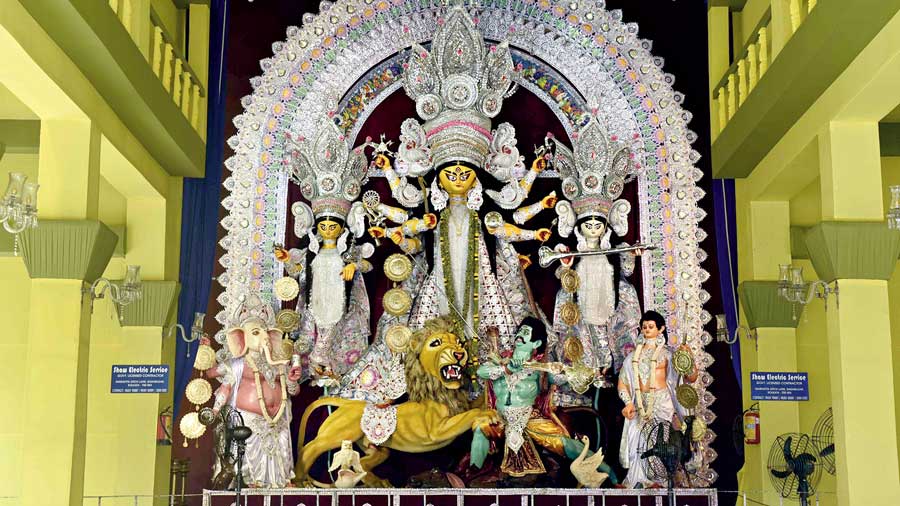Rich taste
Sir — The Bloody Mary — not the Tudor queen but the famous cocktail — allegedly turned 100 this December. There is much debate about the actual origin of this cocktail, but one thing most people would perhaps agree on is that this is not a cocktail for everyone. After all, the ingredients — tomato juice, celery, bacon, salt, olive juice, even vodka — could well make for a delicious warm soup instead of a cocktail. But one thing is for certain — irrespective of the disagreements about the taste of the cocktail, this is not a drink for Indians anymore. The price of tomatoes has shot up across the country — in some states it is more expensive than even petrol — making the Bloody Mary a bit too rich a taste for most.
P. Ganguly,
Calcutta
Inclusive spirit
Sir — It is a matter of great pride that the Unesco has put ‘Durga Puja in Calcutta’ on the Representative List of the Intangible Cultural Heritage of Humanity (“Unesco tag on Durga Puja”, Dec 16). There is perhaps a reason that the Puja in Calcutta was singled out — unlike other parts of the country, where Durga Puja is a ritual of Bengalis coming together to get a feel of their home, in Calcutta Durga Puja celebrations are not restricted to a single religion, caste or community. This is perhaps what Unesco meant when it highlighted the inclusive nature of the festival.
Sayantan Neogi,
Calcutta
Sir — Unesco’s intangible heritage tag for Calcutta’s Durga Puja brought to mind two earlier pieces by Uddalak Mukherjee that need to be read in consonance. In “Monsieur Maurice” (June 26, 2019), Mukherjee writes: “Yet, the intangible... remains peripheral to the imagining and, most disappointingly, conservation of topographies, making the scrutiny of such spaces unrepresentative.” In an earlier piece, “A devi for all?” (Nov 21, 2018), he had highlighted that when it comes to so-called sarbojonin Pujas, “there remains a perceptible inertia to disturb or, more importantly, realign iniquitous equations. It would be interesting to find out how many Puja committees are willing to accept the services of a learned priest who is a Dalit, or, for that matter, a woman, or a member of a sexual minority. How many Muslims — they make up nearly 30 per cent of the state’s population — are invited to partake of the Navami bhog, a feast that supposedly nourishes the idea of the community?” One hopes that the heritage tag does not further isolate the Durga Puja from such scrutiny.
A.K. Sen,
Calcutta
Sir — The bickering between two political parties trying to take credit for the Unesco intangible tag for the Durga Puja is unfortunate. It is neither the Trinamul Congress’s patronage nor the Bharatiya Janata Party’s Hindutva that define the Durga Puja. The people of Calcutta deserve credit for coming together to make the Puja what it is. In fact, politicization of Pujas takes away from the spirit of the Durga Puja. This is why small neighbourhood pandals are better embodiments of the Puja spirit than bigger, more celebrated ones.
Archana Roy,
Calcutta
Sir — If Durga Puja is an intangible cultural heritage then so are the other festivals celebrated by Bengalis: Bangalir baro maashe, tero parbon. These may not find a place on Unesco’s list but the state government should definitely promote these festivals internationally. Once the pandemic is under control, these festivals could turn into lucrative tourism opportunities for West Bengal.
Buddhaditya Das,
Calcutta
Right time
Sir — The Union cabinet’s approval of the proposal to raise the minimum age of marriage for girls from 18 to 21 years is heartening. Indian girls face numerous difficulties when it comes to finishing their education owing to family pressure to get married as soon as they turn 18 — even earlier sometimes. But as long as age-old customs are allowed to dominate society and the youth — both men and women — are not allowed to choose what they want from life for themselves, no law can make a significant difference.
Shivesh Patidar,
Ujjain
Sir — As the nation gears up for a better and brighter future for both genders, raising the legal age of marriage for girls is important. There are reasons to cheer the fact that girls and boys are now at par as far as marriageable age is concerned. But who is going to educate the hapless rural families? In many villages, girls are still bartered like foodgrains. There is a desperate need to spread awareness within the rural community.
Haimanti Dutta Ray,
Calcutta
Trouble afoot
Sir — It is surprising that some political leaders and Calcutta High Court lawyers have reached Dewanganj to help the tribal people of the area protest against the Deocha-Pachami coal mine project (“Stirrings of protest at Deocha”, Dec 19). These people should not try to stir up trouble. The Mamata Banerjee government will not act without keeping in mind the well-being of the people of Bengal. The coal mine project at Deocha-Pachami will not only provide fuel but also create many jobs. The government will surely take measures to rehabilitate people who lose their land. People of Deocha-Pachami should thus stand with the government in this endeavour, not against it.
Shyamal Thakur,
East Burdwan
Sir — Mamata Banerjee knows full well the power of popular revolt — she raided the Red Citadel in West Bengal on the back of one. She should pay heed to the trouble fomenting in Birbhum. The concerns of the tribal people who will be rendered landless merit attention. Moreover, Banerjee should explore alternative, green fuel opportunities. Fossil fuels are no longer viable for the environment.
Rima Roy,
Calcutta











